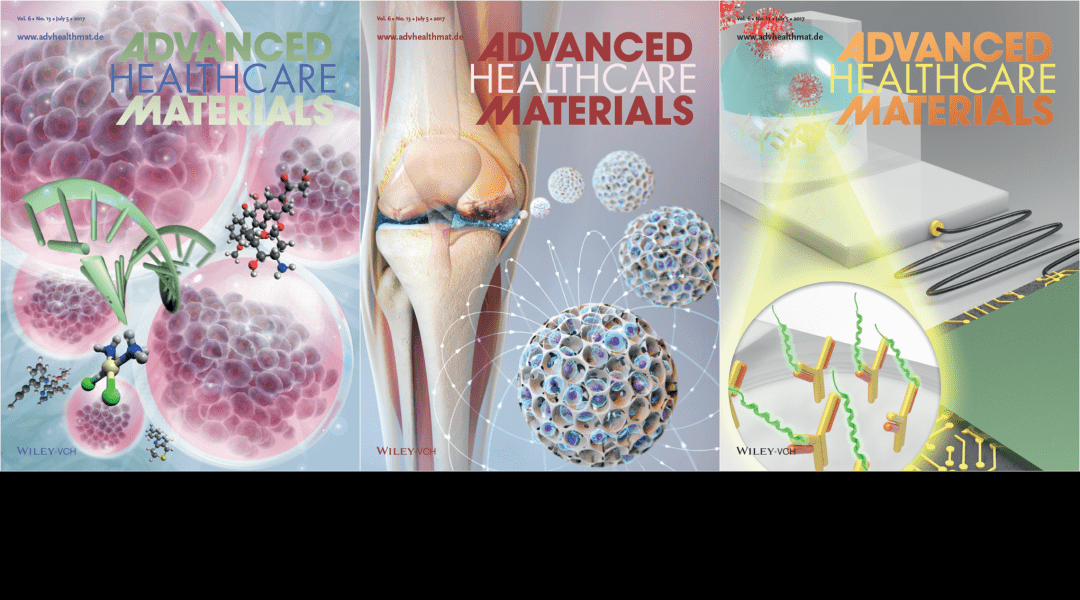Advanced Healthcare Materials celebrates its 5th birthday this year! Since 2012 we have been bringing you the latest breakthroughs in biomedical materials science with a strong focus on improving human health, and we will continue to do so in 2017. Read more about this in our latest editorial.
No access to our published content yet? Make sure to recommend Advanced Healthcare Materials to your librarian. More information can be found here.
In this biweekly feature, we highlight the artwork on the covers of the most recent issue of Advanced Healthcare Materials, and of course the research behind it. You can find this week’s issue here. Click on the titles or cover images below to get to the corresponding papers. Also check out our previous cover art feature here.
by Gwangjun Go, Jiwon Han, Jin Zhen, Shaohui Zheng, Ami Yoo, Mi-Jeong Jeon, Jong-Oh Park, and Sukho Park
Autologous cell-based therapies using scaffolds have led to promising achievements in articular cartilage regeneration. Sukho Park and co-workers at Chonnam National University in Gwangju, Korea describe a magnetically actuated microscaffold with the capability to deliver mesenchymal stem cells for targeted articular cartilage regeneration. They show that this porous scaffold not only can assist in cell adhesion, but also can move to the target site under the control of an external magnetic field.
Detection of Avian Influenza Virus from Cloacal Swabs Using a Disposable Well Gate FET Sensor
of Avian Influenza Virus from Cloacal Swabs Using a Disposable Well Gate FET Sensor
by Sungwook Park, Jaebin Choi, Minhong Jeun, Yongdeok Kim, Seong-Su Yuk, Sang Kyung Kim, Chang-Seon Song, Seok Lee, and Kwan Hyi Lee
Kwan Hyi Lee and co-workers demonstrate a dual-gate FET sensor including a disposable well gate, developed at the Korea Institute of Science and Technology in Seoul, which can detect avian influenza viruses directly in the cloacal swabs of living animals. The disposable well gate, which is chemically optimized to a lysis buffer, allows both lysis and detection of these viruses to occur in a simple, single-well, single-buffer procedure of only 30 minutes.
by Hualin Li, Peng Liu, Guneet Kaur, Xi Yao, and Mengsu Yang
Mengsu Yang, Xi Yao and co-workers at the City University of Hong Kong have prepared transparent nanoparticle-based liquid marbles to culture tumor spheroids in 3D. The formation of tumor spheroids inside these transparent liquid marbles from either a single cancer cell or a population of cells can be optically recorded in a continuous fashion. The tumor spheroids cultured in the marbles show enhanced viability after treatment with chemotherapeutic drugs and small interfering RNA.
A more extensive news article about this study can be found here.
Dendritic Mesoporous Silica Nanoparticles for pH-Stimuli-Responsive Drug Delivery of TNF-Alpha
Mesoporous Silica Nanoparticles for pH-Stimuli-Responsive Drug Delivery of TNF-Alpha
by Arne Kienzle, Sven Kurch, Janine Schlöder, Carsten Berges, Robert Ose, Jonathan Schupp, Andrea Tuettenberg, Henning Weiss, Jennifer Schultze, Svenja Winzen, Meike Schinnerer, Kaloian Koynov, Markus Mezger, Nikolas K. Haass, Wolfgang Tremel, and Helmut Jonuleit
Tumor necrosis factor-alpha (TNF-alpha) is a cytokine and natural endotoxin that can induce regression in tumors, but due to its short half-life and acute toxicity systemic administration is not feasible, preventing its widespread use in cancer treatment. Helmut Jonuleit, Wolfgang Tremel and co-workers at the Johannes Gutenberg University, the Max Planck Institute for Polymer Research (both in Mainz, Germany) and the University of Queensland in Brisbane, Australia have utilized dendritic mesoporous silica nanoparticles for TNF-alpha delivery to increase its efficacy, while decreasing its side effects.


 Magnetically Actuated Micro-Scaffold Containing Mesenchymal Stem Cells for Articular Cartilage Repair
Magnetically Actuated Micro-Scaffold Containing Mesenchymal Stem Cells for Articular Cartilage Repair and Gas-Permeable Liquid Marbles for Culturing and Drug Sensitivity Test of Tumor Spheroids
and Gas-Permeable Liquid Marbles for Culturing and Drug Sensitivity Test of Tumor Spheroids














